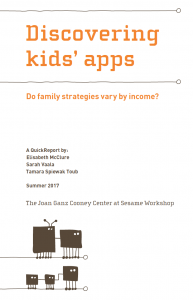Earlier this spring, I had dinner with some new friends who, like my husband and me, are parents of a toddler. Between bites of guacamole, I briefly described the nature of our ongoing research at the Joan Ganz Cooney Center regarding children’s educational apps—and a common interest was ignited. We spent the remainder of the meal discussing the difficulties that we as modern-day parents face in navigating the complexities of screen media in our children’s lives. My friends asked me for guidance on particular apps to use with their daughter, how to know which ones to choose, and how much to let her play with them. I had to admit: my husband and I face the same questions with my own daughter. The guidance is sparse, even for those of us working in this field.

In fact, that very point was the main conclusion from our 2015 scan of children’s literacy apps, Getting a Read on the App Stores. In that analysis of 183 popular and expert-awarded apps for children 0- to 8-years-old, we found considerable variability in the amount and nature of information available to parents in app descriptions within popular app markets (i.e., iTunes, Google Play, and Amazon). Particularly rare in app descriptions were what we called “benchmarks of educational quality,” which include accounts of underlying educational curricula, child development or educational expertise among the app development team, or research testing of apps. No wonder my friends felt overwhelmed with finding apps for their daughter—how are parents supposed to make informed choices with such little information available to them?
While that report offered a sense of the extent of parent-directed information in app markets, it did not assess actual impact on families. That is, while we learned that guidance is inconsistent and lacking in specific information regarding educational development of apps, we wondered: does that lack of guidance actually matter for parents and for the decisions families make about children’s apps? So, we decided to ask a large sample of U.S. parents about the sources and strategies they rely on for help choosing apps for their children.

Today, we are releasing a QuickReport which takes the next step in our analysis of the family app ecology. In Discovering Kids’ Apps, my colleagues, Elisabeth McClure and Tamara Spiewak Toub, and I examine the sources of information and app-selection strategies reported by a national sample of over 1,100 parents with 3- to 6-year-old children. To start to get a sense of how experiences may vary or converge across diverse families, we looked for similarities and differences between families with lower (less than $50,000), middle ($50,000 – $99,999) and higher household incomes ($100,000 or more). What we found builds upon our findings from the 2015 app scan in several notable ways:
- Parents’ perceptions of the educational value of apps are consistent across income groups, as are children’s app use rates. We found similar rates of agreement with the belief that “educational apps are valuable learning tools for children” among lower, middle, and higher income parents who took our survey. While this represents a fairly limited way to measure parents’ beliefs about apps, we also found similar rates of children’s app use frequency across the three income groups. Thus, it seems from these preliminary data that any differences in how parents find apps or what apps their children ultimately use are likely not driven by fundamentally divergent perspectives on the value or role of children’s apps in general.
- Wealthier families tend to own more paid apps, which may lead to differences in app quality across families. Our findings suggest that children in families with middle and higher incomes tend to own more paid apps than their peers in lower income families. In fact, 43% of lower income parents in this study reported that their children had only free apps, compared to fewer than 15% of middle and higher income parents. So while frequency of app use may be similar, the app content that children engage with may vary with income (as well as other potential family characteristics). In the 2015 app scan we found that children’s apps that had won accolades from expert reviewers tend to cost more than apps simply promoted by app stores. In that study, descriptions of paid apps were also slightly more likely than descriptions of free apps to mention usability/appeal testing or involvement of an education or child development expert in app development. In light of the lack of known efficacy testing of children’s apps, whether actual educational quality varies consistently based on the cost of apps is an open question (and an important one).
- The guidance available or lacking within app markets may disproportionately impact families with lower incomes. Our findings offered several hints that lower income families may tend to rely more on information available within the app market than do middle or higher income parents. When asked about their top sources of information for finding children’s apps, two-thirds of parents in lower income households reported consulting one or more sources within the app stores (such as app descriptions or consumer reviews), compared to just over half of middle (54%) and higher income (51%) families. Additionally, middle and higher income parents reported greater skepticism that app descriptions contained valuable information. In fact, 70% of higher income parents agreed that app descriptions “rarely tell you anything useful about a children’s app”, compared to 40% of lower income parents who felt the same.
We hope that reading Discovering Kids’ Apps will inspire more burning questions than satisfying answers for you, as it has for us. Perhaps it will initiate many more lively dinner discussion with friends and family… That is by design! The primary goal of the Cooney Center QuickStudy research series is to spur subsequent, deeper inquiry among our research partners and colleagues. Our team is already engaged in some additional research regarding the family app ecology, including an analysis of in-depth parent interviews that add texture and meaning to some of the numbers and patterns suggested by the survey findings. Please get in touch if you have questions about this research or ideas for follow-up inquiry!
